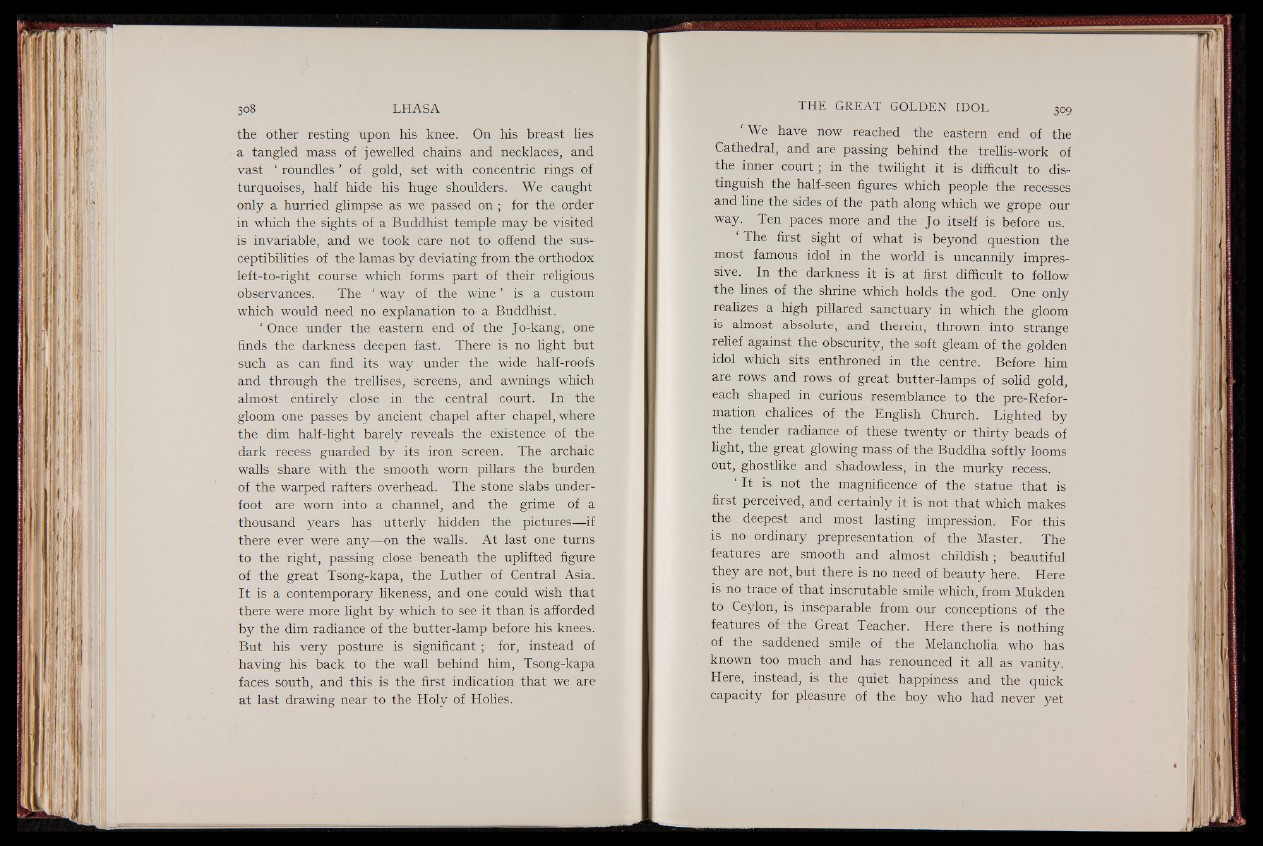
the other resting upon his knee. On his breast lies
a tangled mass of jewelled chains and necklaces, and
vast ‘ roundles ’ of gold, set with concentric rings of
turquoises, half hide his huge shoulders. We caught
only a hurried glimpse as we passed on ; for the order
in which the sights of a Buddhist temple may be visited
is invariable, and we took care not to offend the susceptibilities
of the lamas by deviating from the orthodox
left-to-right course which forms part of their religious
observances. The ‘ way of the wine ’ is a custom
which would need no explanation to a Buddhist.
‘ Once under the eastern end of the Jo-kang, one
finds the darkness deepen fast. There is no light but
such as can find its way under the wide half-roofs
and through the trellises, screens, and awnings which
almost entirely close in the central court. In the
gloom one passes by ancient chapel after chapel, where
the dim half-light barely reveals the existence of the
dark recess guarded by its iron screen. The archaic
walls share with the smooth worn pillars the burden
of the warped rafters overhead. The stone slabs underfoot
are worn into a channel, and the grime of a
thousand years has utterly hidden the pictures— if
there ever were any— on the walls. At last one turns
to the right, passing close beneath the uplifted figure
of the great Tsong-kapa, the Luther of Central Asia.
It is a contemporary likeness, and one could wish that
there were more light by which to see it than is afforded
by the dim radiance of the butter-lamp before his knees.
But his very posture is significant; for, instead of
having his back to the wall behind him, Tsong-kapa
faces south, and this is the first indication that we are
at last drawing near to the Holy of Holies.
‘ We have now reached the eastern end of the
Cathedral, and are passing behind the trellis-work of
the inner co u r t; in the twilight it is difficult to distinguish
the half-seen figures which people the recesses
and line the sides of the path along which we grope our
way. Ten paces more and the Jo itself is before us.
The first sight of what is beyond question the
most famous idol in the world is uncannily impressive.
In the darkness it is at first difficult to follow
the lines of the shrine which holds the god. One only
realizes a high pillared sanctuary in which the gloom
is almost absolute, and therein, thrown into strange
relief against the obscurity, the soft gleam of the golden
idol which sits enthroned in the centre. Before him
are rows and rows of great butter-lamps of solid gold,
each shaped in curious resemblance to the pre-Refor-
mation chalices of the English Church. Lighted by
the tender radiance of these twenty or thirty beads of
light, the great glowing mass of the Buddha softly looms
out, ghostlike and shadowless, in the murky recess.
‘ It is not the magnificence of the statue that is
first perceived, and certainly it is not that which makes
the deepest and most lasting impression. For this
is no ordinary prepresentation of the Master. The
features are smooth and almost childish; beautiful
they are not, but there is no need of beauty here. Here
is no trace of that inscrutable smile which, from Mukden
to Ceylon, is inseparable from our conceptions of the
features of the Great Teacher. Here there is nothing
of the saddened smile of the Melancholia who has
known too much and has renounced it all as vanity.
Here, instead, is the quiet happiness and the quick
capacity for pleasure of the boy who had never yet